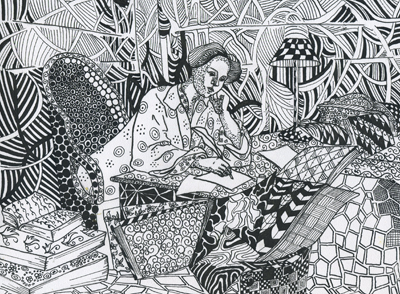Writing Stories in Scenes
Short pieces are beautiful because each one has a definite beginning, middle, and end, and because they can be put together to make a longer piece or a whole book. They allow writers to think small, go deep, stay focused, and let go of tangents that are not relevant to the current story. (Interesting tangents can be developed later.) The practice of sorting through memories and scenes and choosing the best or ripest ones helps writers shape their material into finished pieces.
Here’s a fabulous writing exercise that can help fiction and nonfiction writers of all ages (junior high and up) practice the art of writing stories in scenes. I came across this exercise in Dagny Dingman’s twelfth-grade English class at Berkeley High School, where I serve as a writing coach through WriterCoach Connection. She thanks Amy Crawford who thanks David Bye for this exercise. With thanks to them all, I have modified and expanded the directions here. As soon I can clear some time to explore my material, I’m going to give this exercise a whirl.
Educational Vignettes, Step by Step
1. Identify the material you’d like to explore. If you’re not sure where to begin, try making lists of
- your earliest memories
- events or experiences that changed your life
- people who influenced you
- challenges you’ve faced
- hardships you’ve overcome
- things you learned when you thought you failed
- happiest/saddest times of your life
- biggest surprises of your life
- most embarrassing experiences
- most meaningful experiences
- stories you often tell
- stories you’ve been reluctant to tell
2. Make a list of five or more memories that you think you could turn into scenes or stories. Choose the material that has the most energy for you right now.
3. Ask yourself questions about this material and respond in writing. What happened? How did it happen? Who was there? What was the place like? What happened next? What did you discover? Keep asking questions and answering them in writing; this practice will help you deepen your memory of what happened and your sense of why it was important to you. Focus on senses. What did it look like, taste like, smell like? How did it sound? How did it feel?

Sherman Alexie at the Texas Book Festival, Austin, 2007.
Photo copyright Larry D. Moore; via Wikimedia Commons.
5. Using Alexie’s story as a model, write five or more vignettes. Focus on scenes and sense details. Look for a common thread that runs through these scenes. Focus on meaning.
6. Revise and polish your vignettes to make them shine. Think short and sweet. Let go of any words or phrases or lines that don’t move the narrative forward. Rework sentences and paragraphs until each vignette stands on its own and works together with all the vignettes to form a powerful story.
My Notes on “Indian Education”
Here’s what I’ve observed about Alexie’s “Indian Education”:
- Each vignette in the story zeroes in on a significant event and reveals its impact on the narrator, the suffering, injustice, and subsequent insights he experienced, the lessons learned.
- In all of the vignettes the author presents a scene with one event or several related events; he never says how the narrator felt; instead he shows what the narrator said or did during the event. The narrator’s actions produce emotion; his reflections reveal meaning.
- All the vignettes are compact, between 75 and 200 words.
- They are connected structurally, moving from first to twelfth grade, with a class reunion postscript.
- They are connected thematically; the piece is not about classroom learning; it’s about life learning.
- Each vignette is infused with meaning, and the meaning of the story deepens as the narrative builds, one scene after another.
Short pieces are easy to envision, but that does not mean they are easy to write. They may require lots of time to develop and revise … and revise … and revise. Have at it!
Resources
- In “The Multiple Selves Within: Crafting Narrative Personae in Literary Memoir,” author Michael Steinberg explores the different voices memoirists use. This piece is adapted from a 2012 AWP panel discussion and appears in Triquarterly.
- Nancie Atwell’s “Questions for Memoirists,” from her book Lessons That Change Writers, is a helpful tool for brainstorming topics, especially for young writers.
- Learn more about Sherman Alexie at his website.
- See more of my posts on writing memoir.
How did this exercise work for you? How do you like writing scenes?



thank you! helpful and writerly… can’t wait to read the book that comes out of this for you! (Another writer I’ve used a lot in writing workshops is Sondra Perl –her little book
FELT SENSE that comes with a CD and her reading the guidelines that bring up new images, words, etc., that help to negotiate the liminal area between what we know and what we don’t yet know…and her book WRITING TRUE, that has longer, fuller, and more traditional writing and workshopping chapters.
Thanks to you, Ruth, for the reference to Sondra Perl’s Felt Sense. Looks like it’s out of print, but I did a Web search and found some of her guidelines. It’s great stuff!